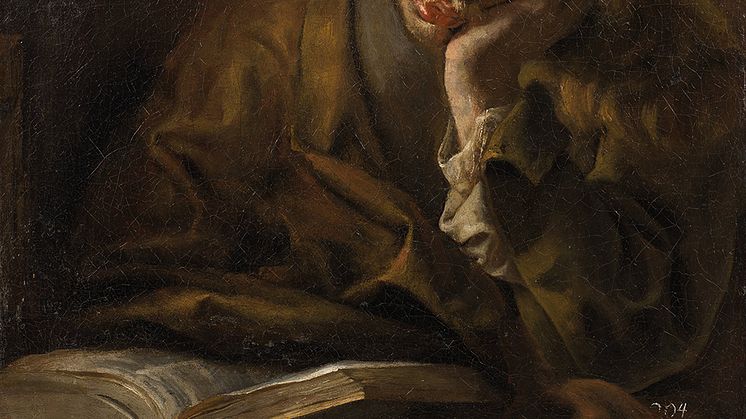
Press release -
Nationalmuseum Sweden acquires painting by a Rembrandt-pupil
Nationalmuseum in Stockholm has acquired the painting Young Man Asleep Before an Open Book, probably executed in Rembrandt’s studio in the mid-17th century. In the Dutch Golden Age, the motif of a young man asleep, or lost in thought, before a book was seen as an allegory of Sloth, one of the seven deadly sins. The museum’s new acquisition has a well-documented history dating back to the Viennese art collection of the Empress Maria Theresia. The acquisition was made possible by a generous donation of the Wiros Fund.
Numerous artists came to Amsterdam to receive instruction from Rembrandt, some of them the most gifted of their generation. Rembrandt successfully taught them to emulate his style, which explains the large number of high-quality works that remain anonymous to this day. For example, tronies, or character studies, of young men, for which the students used each other as models. Among these anonymous works is the painting of a Young Man Asleep Before an Open Book. Since the late 18th century, when the painting was recorded in the Austrian imperial art collection in Vienna, attributions have been made to one or another of the many pupils or followers of Rembrandt. Its motif and style indicate that it probably took shape on an easel in Rembrandt’s studio around 1650-1655.
"We are very happy for this opportunity to supplement our unique, internationally renowned collection of Rembrandt’s works with such an excellent example of Dutch genre painting by an artist in the master’s immediate circle", says Magnus Olausson, Senior Researcher and former Director of Collections.
"Our hope is that further research and technical investigation will allow us to eventually identify the artist", he contiues.
The painting depicts a seemingly banal scene. However, the figure of the sleeping youth, his head resting in one hand and the other hand concealed under his cloak, conforms to the related iconographic types of melancholia and sloth, as they were represented in art since the Middle Ages. Exhaustion, sorrow and, finally, idleness were thought to be the outcome of an overactive mind. Our sleeping young scholar seems to have fallen prey to sloth for this reason, his neglect of duties accentuated by the open book that lies unused before him. The image served as an admonition to make good use of one’s brief allotted time. Rembrandt had explored the subject of the sleeper in the late 1620s and mid-1630s, while the theme of the idle student circulated in and around his studio in the 1640s and ‘50s. The Protestant communities of the Netherlands provided a ready market for such moralising genre pieces.
The composition is strikingly bold and dynamic. The young man is depicted in half-figure, leaning forward, and filling up the picture space. The palette is dominated by warm brownish hues. A single light source lights the left side of the figure, causing deep shadows to be cast across the man’s face, and in the folds of his cloak. The painterly open brush work, especially in the face and hair, reveals the hand of an accomplished artist, clearly inspired by the bold painterly handling Rembrandt was developing in the early 1650s. Most impressive are the scumbled impasto strokes of yellow and ochre-red paint in the man’s unkempt hair, and the beautifully observed fall of light in the face, delicately highlighting the full lips and the hairs of the overgrown moustache.
Nationalmuseum relies on gifting and financial support from private foundations and trusts to enhance its public collections of fine art, applied art and design. The acquisition was made possible by a generous donation of the Wiros Fund.
Inventory number: NM 7693.
Oil on canvas, 63 x 63 cm
For further information
Martin Olin, Director of Collections, martin.olin@nationalmuseum.se,
+46 8 5195 4310
Lena Munther, Director of Communication, press@nationalmuseum.se,
+46 8 5195 4400
Categories
Nationalmuseum is Sweden’s museum of art and design. The collections comprise some 700 000 objects, including paintings, sculpture, drawings and graphic art from the 16th century up to the beginning of the 20th century and the collection of applied art and design up to the present day. Nationalmuseum is a government authority with a mandate to preserve cultural heritage and promote art, interest in art and knowledge of art.

